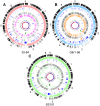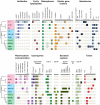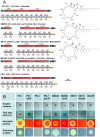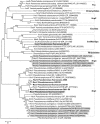Comparative genomics of plant-associated Pseudomonas spp.: insights into diversity and inheritance of traits involved in multitrophic interactions
- PMID: 22792073
- PMCID: PMC3390384
- DOI: 10.1371/journal.pgen.1002784
Comparative genomics of plant-associated Pseudomonas spp.: insights into diversity and inheritance of traits involved in multitrophic interactions
Abstract
We provide here a comparative genome analysis of ten strains within the Pseudomonas fluorescens group including seven new genomic sequences. These strains exhibit a diverse spectrum of traits involved in biological control and other multitrophic interactions with plants, microbes, and insects. Multilocus sequence analysis placed the strains in three sub-clades, which was reinforced by high levels of synteny, size of core genomes, and relatedness of orthologous genes between strains within a sub-clade. The heterogeneity of the P. fluorescens group was reflected in the large size of its pan-genome, which makes up approximately 54% of the pan-genome of the genus as a whole, and a core genome representing only 45-52% of the genome of any individual strain. We discovered genes for traits that were not known previously in the strains, including genes for the biosynthesis of the siderophores achromobactin and pseudomonine and the antibiotic 2-hexyl-5-propyl-alkylresorcinol; novel bacteriocins; type II, III, and VI secretion systems; and insect toxins. Certain gene clusters, such as those for two type III secretion systems, are present only in specific sub-clades, suggesting vertical inheritance. Almost all of the genes associated with multitrophic interactions map to genomic regions present in only a subset of the strains or unique to a specific strain. To explore the evolutionary origin of these genes, we mapped their distributions relative to the locations of mobile genetic elements and repetitive extragenic palindromic (REP) elements in each genome. The mobile genetic elements and many strain-specific genes fall into regions devoid of REP elements (i.e., REP deserts) and regions displaying atypical tri-nucleotide composition, possibly indicating relatively recent acquisition of these loci. Collectively, the results of this study highlight the enormous heterogeneity of the P. fluorescens group and the importance of the variable genome in tailoring individual strains to their specific lifestyles and functional repertoire.
Conflict of interest statement
The authors have declared that no competing interests exist.
Figures








Similar articles
-
Genome sequence reveals that Pseudomonas fluorescens F113 possesses a large and diverse array of systems for rhizosphere function and host interaction.BMC Genomics. 2013 Jan 25;14:54. doi: 10.1186/1471-2164-14-54. BMC Genomics. 2013. PMID: 23350846 Free PMC article.
-
Genomic and genetic analyses of diversity and plant interactions of Pseudomonas fluorescens.Genome Biol. 2009;10(5):R51. doi: 10.1186/gb-2009-10-5-r51. Epub 2009 May 11. Genome Biol. 2009. PMID: 19432983 Free PMC article.
-
Diversity of phytobeneficial traits revealed by whole-genome analysis of worldwide-isolated phenazine-producing Pseudomonas spp.Environ Microbiol. 2019 Jan;21(1):437-455. doi: 10.1111/1462-2920.14476. Epub 2018 Dec 17. Environ Microbiol. 2019. PMID: 30421490
-
Roadmap to new virulence determinants in Pseudomonas syringae: insights from comparative genomics and genome organization.Mol Plant Microbe Interact. 2008 Jun;21(6):685-700. doi: 10.1094/MPMI-21-6-0685. Mol Plant Microbe Interact. 2008. PMID: 18624633 Review.
-
Pseudomonas genomes: diverse and adaptable.FEMS Microbiol Rev. 2011 Jul;35(4):652-80. doi: 10.1111/j.1574-6976.2011.00269.x. Epub 2011 Mar 25. FEMS Microbiol Rev. 2011. PMID: 21361996 Review.
Cited by
-
Isolation, identification and pathogenicity of local entomopathogenic bacteria as biological control agents against the wild cochineal Dactylopius opuntiae (Cockerell) on cactus pear in Morocco.Sci Rep. 2023 Dec 8;13(1):21647. doi: 10.1038/s41598-023-48976-8. Sci Rep. 2023. PMID: 38062128 Free PMC article.
-
Improved assessments of bulk milk microbiota composition via sample preparation and DNA extraction methods.PLoS One. 2022 Sep 15;17(9):e0267992. doi: 10.1371/journal.pone.0267992. eCollection 2022. PLoS One. 2022. PMID: 36107863 Free PMC article.
-
Draft Genome Sequences of Five Pseudomonas fluorescens Subclade I and II Strains, Isolated from Human Respiratory Samples.Genome Announc. 2015 Jul 30;3(4):e00837-15. doi: 10.1128/genomeA.00837-15. Genome Announc. 2015. PMID: 26227600 Free PMC article.
-
Functional genomics analysis of a phyllospheric Pseudomonas spp with potential for biological control against coffee rust.BMC Microbiol. 2022 Sep 22;22(1):222. doi: 10.1186/s12866-022-02637-4. BMC Microbiol. 2022. PMID: 36131235 Free PMC article.
-
Harnessing the genomic diversity of Pseudomonas strains against lettuce bacterial pathogens.Front Microbiol. 2022 Dec 22;13:1038888. doi: 10.3389/fmicb.2022.1038888. eCollection 2022. Front Microbiol. 2022. PMID: 36620043 Free PMC article.
References
-
- Lessie TG, Phibbs PV., Jr Alternative pathways of carbohydrate utilization in Pseudomonads. Annu Rev Microbiol. 1984;38:359–388. - PubMed
-
- Gross H, Loper JE. Genomics of secondary metabolite production by Pseudomonas spp. Nat Prod Rep. 2009;26:1408–1446. - PubMed
-
- Raaijmakers JM, Vlami M, de Souza JT. Antibiotic production by bacterial biocontrol agents. Antonie Van Leeuwenhoek. 2002;81:537–547. - PubMed
Publication types
MeSH terms
Substances
LinkOut - more resources
Full Text Sources
Molecular Biology Databases
Miscellaneous

